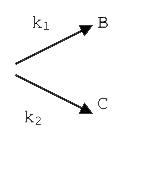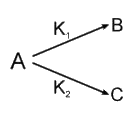A substance undergoes first order decomposition. The decomposition follows two parallel first order reactios as:
and K1=1.26×10−4sec−1,K2=3.80×10−5sec−1

The percentage distribution of B and C are Solution in Telugu
80% B and 20%C
76.83% B and 23.17%C
90%B and 10%C
60%B and 40%C
The correct Answer is:B
yB=K1K1+K2=1.26×10−4(1.26+0.380)10−4=1.261.64=0.76.88,yB=76.88%yc=23.2
Topper's Solved these Questions
- CHEMICAL KINETICSBook:AAKASH SERIESChapter:CHEMICAL KINETICSExercise:PRACTICE SHEET-2 (LINKED COMPRHENSION TYPE QUESTIONS)
Explore 6 Videos
- CHEMICAL KINETICSBook:AAKASH SERIESChapter:CHEMICAL KINETICSExercise:PRACTICE SHEET-2 (MATCH THE FOLLOWING QUESTIONS)
Explore 2 Videos
- CHEMICAL KINETICSBook:AAKASH SERIESChapter:CHEMICAL KINETICSExercise:PRACTICE SHEET-1 (INTEGER ANSWER TYPE QUESTIONS)
Explore 6 Videos
- CHEMICAL KINETCSBook:AAKASH SERIESChapter:CHEMICAL KINETCSExercise:EXERCISE - 3.2
Explore 45 Videos
- CHEMICAL THERMODYNAMICSBook:AAKASH SERIESChapter:CHEMICAL THERMODYNAMICSExercise:Additional Practice Exercise
Explore 54 Videos
Similar Questions
Elemantary unimolecular reactions have first order rate laws, elementary bimolecular reactions have second order rate laws. A rate law is often derived from a proposed mechanism by imposing the state approximation or by assuming that there is a pre -equilibrium. A proposed mechanism must be consistent with the experiment rate law.
The decomposition of O3 obeys the mechanism give below
Step 1: O3⇔O2+(O) (both forward and backward reactions are fast)
Step 2: O3+(O)slow−−→O2+O2 (ignore) backward reaction), the rate of reaction is given by
View SolutionMatch the following columns

View SolutionIn a gaseous phase reaction A2(g)→B(t)+1(1/2)C(g), the increase in pressure from 100 mm to 120 mm is noticed in 5 minute.The rate of disappearance of A2 in mm min−1 is
View SolutionDiscuss on the kinetic spontaneity of a chemical reaction. Is a slow reaction spontaneous? Why?
View SolutionWhich among the following is not an exact differential?
View SolutionA subtance undergoes first order decomposition involving two parallel first order reaction as : The mole percent of B in the products is :
View SolutionThe first order rate constant for the decomposition of N_(2)O_(5) is 6.2 xx 10^(-4) sec^(-1) . The t_(1//2) of decomposition is
View SolutionA substance undergoes first order decomposition. It follows two first order reaction as follow:

View SolutionThe substance undergoes first order decomposition.The decomposition follows two parallel first order reactons as : K_1=10^(-2) sec^(-1) and K_2=10^(-2)sec^(-1) If the corresponding activation energies of parallel reaction are 100 and 120 kJ "mol"^(-1) then the net activation energy of A is/are:
View SolutionA substance undergoes first order decomposition. The decomposition follows two parallel first order reaction as :

The precentage distribution of B and C are :
View SolutionA substance undergoes first order decomposition. The decomposition follows two parallel first order reactions as :
k1=1.26×10−4s−1,k2=3.8×10−5s−1
The percentage distribution of B and C are :

View SolutionThe substance undergoes first order decomposition. The decomposition follows two parallel first order reactions as : K_(1)=1.26xx10^(-4) sec^(-1) and K_(2) =3.8xx10^(-5) sec^(-1) The percentage distribution of B and C
View SolutionA substance undergoes first order decomposition. The decomposition follows two parallel first order reactions as The % distribution of B and C is ................ and .................. respectively.
View SolutionA substance undergoes first order decomposition. The decomposition follows two parallel first order reactions as , k_(1)=1.26xx10^(-4)" sec"^(-1) and k_(2)=3.6xx10^(-5)" sec"^(-1) Calculate the % distribution of B & C.
View SolutionThe substance undergoes first order decomposition. The decomposition follows two parallel first order reactions as :

K1=1.26×10−4sec−1andK2=3.8×10−5sec−1 The percentage distribution of B and C
View SolutionA substance undergoes a first order decomposition. The decomposition follows two parallel first order reactions as

The percentage distribution of B and C are
View Solution

